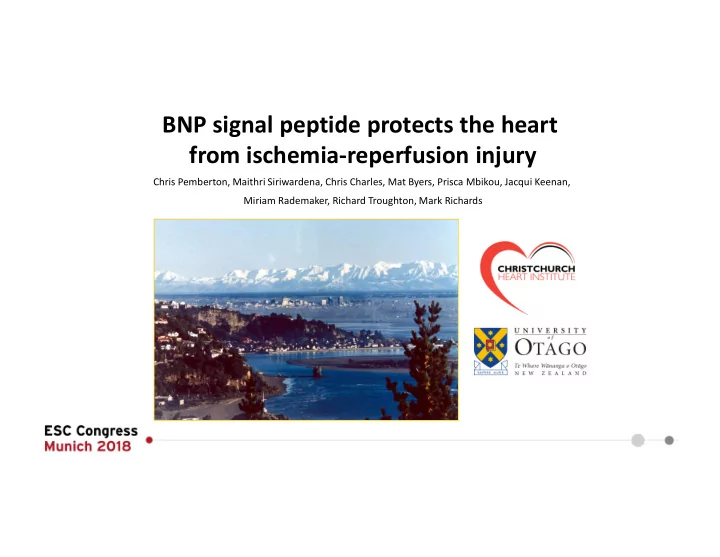

BNP signal peptide protects the heart from ischemia-reperfusion injury Chris Pemberton, Maithri Siriwardena, Chris Charles, Mat Byers, Prisca Mbikou, Jacqui Keenan, Miriam Rademaker, Richard Troughton, Mark Richards
Mechanism of ischemia/injury mediated cell death Hausenloy, Yellon, 2013. J Clin Invest. 2; 123(1): 92–100. Bell et al. 2016 Basic Res Cardiol. 111(4):41.
Cardio-protection pathways Hausenloy DJ et al. 2016 Basic Res Cardiol. 111(6): 70.
There is a clear need for novel ischemia/reperfusion therapies Signal peptides are generally thought to be destroyed at translation. We discovered the signal peptide from BNP to be present in the circulation Siriwardena et al. 2010 Circulation 122: 255
BNPsp is elevated in blood very early after ACS Pemberton et al. 2016 Clin Biochem 49: 645-650 Siriwardena et al. 2010 Circulation 122: 255-264 Liebetrau et al. 2015 Clin Chem 61: 1532-1539
Quaeritur : is BNPsp passive or active during its ACS release - 1? Investigated ex vivo potential of human BNPsp to be protective in cardiac ischemia Rat ex vivo isolated heart i schemia model (n=35 pre-condition, n= 28 at reperfusion) Precondition Reperfusion only administration Paced 310bpm Heart Peptide Global Equilibration Reperfusion excision or control Ischaemia infusion 40min Sampling Timepoints 0 30 2 5 10 15 90min 30 60 • Haemodynamics • Perfusate sampling – cTnI, myoglobin • TUNEL staining, Caspase 3 staining • Western Blot analysis of signalling proteins
Troponin I Release 1.5 TUNEL positive cell ᵠ = P<0.01 vs control 100 1.0 10nmol (pre) control (n=9) *P<0.05 Troponin I ( g/L) 10nmol (n=8) 0.3nmol (pre) % apoptotic cells 80 0.3nmol (n=10) 0.1nmol (n=8) 1 nmol (IDR) 60 Control 0.5 * * * * 40 0.3nmol/L preconditioning 1 nmol/L at reperfusion 20 -50 0 50 100 Time from Reperfusion (minutes) 0 ) ) ) l e e R o r r D r p p t n ᵠ I ( ( ( o ᵠ l l o o l C o m m m n n n 0 3 1 . 1 0 10nmol/L preconditioning Control Troponin I Release 1.5 ᵠ = P<0.01 vs control 1.0 Troponin I ( g/L) Control (n=9) Caspase-3 staining tended to reduce 0.5 IDR 0.3 (n=8) IDR 1 (n=8) -50 0 50 100 Time from Reperfusion (minutes) ᵠ ᵠ
% pERK 1/Total ERK is upregulated by lower BNPsp doses pERK1 pERK2 3nM 0.3nM 1nM * * BNPsp BNPsp BNPsp Sham Control p ERK1 p ERK2 TotErk • Significant difference from Sham p< 0.05 for pERK1 • Control n=6, sham n=6, 0.3nM n=5, 1nM n=6, 3nM n=5
pAkt is unaltered by low, but inhibited by higher BNPsp 0.3nM 1nM 3nM * * * Control Sham BNPsp BNPsp BNPsp 120 74.18 79.36 78.19 100 pAkt % pAkt/Total Akt 80 ᵠ 42.98 40.72 60 40 Total Akt 20 0 Control Sham 0.3nMBNP 1nMBNPsp 3nMBNPsp * p< 0.01 vs. control ᵠ p<0.01 vs. sham Control n=6, sham n=6, 0.3nM n=5, 1nM n=6, 3nM n=5
Quaeritur : is BNPsp passive or active during its ACS release - 2? Investigated in vivo potential of human BNPsp to be protective in cardiac ischemia Ovine in vivo normal animal infusions (n=6) Ovine in vivo pre-conditioning ischemia model (control n=7, BNPsp Tx n= 8) • LCA (angiocath), jugular (polyeth and PA Swan ganz) and Foley urinary cannulation • Continuous 150min BNPsp infusion across ischemia • Reversible ischemia via 90min snare • Haemodynamics • Echo to determine LVEF & AAR • Blood sampling – cTnI, BNPsp • TUNEL staining, Caspase 3 staining • Infarct size/AAR determination by sectioning on day 6/7 after euthanasia
h BNP-sp levels (pmol/L) Normal sheep infusions
Ischemia-reperfusion animals Hemodynamics Echocardiography Control BNPsp - P value Number of 2.63 (±0.460) 2.86 (±0.690) 0.48 segments of LV (AAR) Pre-op LV vol 69.8 (±14.9) 75.2 (±16.2) 0.86 diast (ml) Pre-op LV vol 31.7 (±6.9) 32.5 (± 9.0) 0.85 systol (ml) Pre-op 56.4 (±5.5) 55.9 (±6.4) 0.63 LVEF(%) Post-op LV vol 72.8 (±21.9) 75.5 (±23.4) 0.72 diast (ml) Post-op LV vol 44.1 (±13.1) 50.2 (±15.9) 0.77 systol (ml) Post-op 40.3 (±5.2) 44.2 (±6.9) 0.38 LVEF(%)
Troponin I Release in Sheep Infarction Study 200 Anita Jackie Delilah Elba Isabella Fiona 150 Cala Lydia Achieved hBNPsp levels -Sheep Infarction Study Moa Olivia Troponin I ( g/L) Naomi Rena 15000 Qutie Gabby 100 Kate 50 10000 hBNPsp (pmol/L) 0 50 100 150 200 sheep 1 sheep 2 Time (hours) sheep 3 5000 sheep 4 sheep 5 sheep 6 sheep 7 0 0 15 infused at 1mcg/kg/min P<0.05 * Large variation in achieved levels of human BNPsp in vivo
TUNEL stain BNPsp Caspase-3 stain BNPsp TUNEL stain control Caspase-3 stain control Final size of infarct indexed to area at risk 30 p=0.04 % LV infarcted/ area at risk 100 20 p=0.04 80 % Apoptotic cells 10 60 Like ex vivo rat heart, 40 trend to reduced Caspase-3 0 p l o s 20 r P t n N o B C 0 p l o s r P t N n o B C
Conclusions • BNPsp does not appear to have any major biological actions in the setting of normal cardiac function or health • However, BNPsp has cardio-protective actions in the setting of I/R injury • Ex vivo cardiac function is improved by BNPsp post-I/R, with concomitant reductions in troponin release and DNA fragmentation (TUNEL). Caspase-3 activation trended towards a reduction whereas pERK1 is significantly activated at the dose range 0.3-1nM; pAkt activation is inhibited at higher doses (>3nM). • In vivo , BNPsp reduces infarct size/AAR by a remarkable ~50%, troponin release by ~25%, DNA fragmentation and may improve cardiac function. • The actions of BNPsp appear dose dependent and look likely to follow the U-shaped curve well known for other Tx agents. Any effect on receptor actions is unknown. The half-life/clearance mechanism of BNPsp is unknown, but may involve the liver (Siriwardena et al. Circulation 2010 122:255-264) .
Research group and funding sources Maithri Siriwardena Chris Charles Prisca Mbikou
Recommend
More recommend